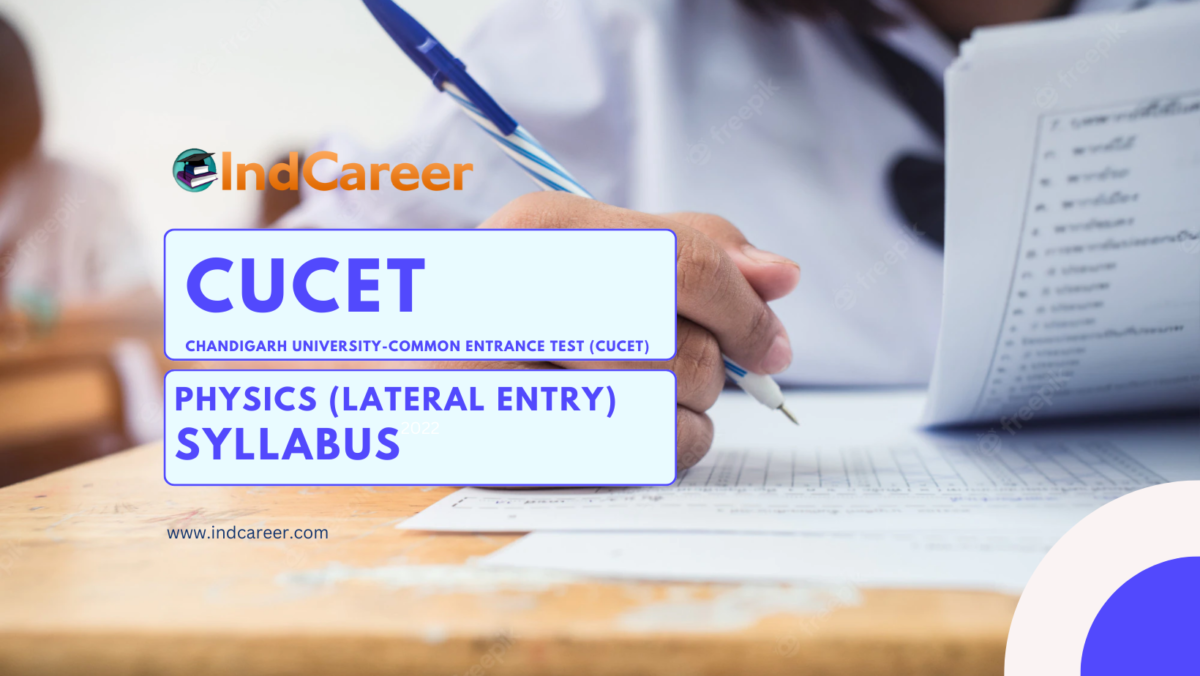Contents
Chandigarh University has decided to conduct an entrance cum scholarship test named as Chandigarh University Common Entrance Test (CUCET) for admission to various programs so as to provide an opportunity to bright and inquisitive young minds from across the country to study in most challenging and diverse academic environment.
CUCET Syllabus has been released by the authorities of Chandigarh University. Candidates can check the syllabus of CUCET 2023 to know the subjects, units and topics that have to be studied for the upcoming entrance examination. The subject-wise CUCET syllabus will allow the candidates to become familiar with the topics that they have to prepare to excel in the examination. Read to know more about CUCET Syllabus 2023.
CUCET Physics (Lateral Entry) Syllabus
Physics (Lateral Entry)
Unit-1: Units and Dimension
- Physical quantities Units – fundamental and derived units, systems of units (FPS, CGS and SI units)
- Dimensions and dimensional formulae of physical quantities (area, volume, velocity, acceleration, momentum, force, impulse, work, power, energy, surface tension, coefficient of viscosity, stress, strain, moment of inertia, gravitational constant.)
- Principle of homogeneity of dimensions
- Dimensional equations and their applications, conversion from one system of units to other, checking of dimensional equations and derivation of simple equations)
- Limitations of dimensional analysis
- Error in measurement, absolute error, relative error, rules for representing significant figures in calculation.
- Application of units and dimensions in measuring length, diameter, circumference, volume, surface area etc. of metallic and non-metallic blocks, wires, pipes etc (at least two each).
Unit-2: Force and Motion
- Scalar and vector quantities – examples, representation of vector, types of vectors
- Addition and Subtraction of Vectors, Triangle and Parallelogram law (Statement only), Scalar and Vector Product.
- Resolution of Vectors and its application to lawn roller.
- Force, Momentum, Statement and Derivation of Conservation of linear momentum, its applications such as recoil of gun.
- Impulse and its Applications
- Circular motion, definition of angular displacement, angular velocity, angular acceleration, frequency, time period.
- Relation between linear and angular velocity, linear acceleration and angular acceleration (related numerical)
- Expression and Applications of Centripetal and centrifugal forces with examples such as banking of roads and bending of cyclist
- Application of various forces in lifts, cranes, large steam engines and turbines
Unit-3: Work, Power and Energy
- Work: and its units, examples of zero work, positive work and negative work
- Friction: modern concept, types, laws of limiting friction, Coefficient of friction and its Engineering Applications.
- Work done in moving an object on horizontal and inclined plane for rough and plane surfaces with its applications
- Energy and its units: Kinetic energy and gravitational potential energy with examples and their derivation
- Principle of conservation of mechanical energy for freely falling bodies, examples of transformation of energy.
- Power and its units, calculation of power in numerical problems
- Application of Friction in brake system of moving vehicles, bicycle, scooter, car trains etc.
Unit-4: Rotational Motion
- Concept of translatory and rotatory motions with examples
- Definition of torque and angular momentum and their examples
- Conservation of angular momentum (quantitative) and its examples
- Moment of inertia and its physical significance, radius of gyration for rigid body, Theorems of parallel and perpendicular axes (statements only), Moment of inertia of rod, disc, ring and sphere (hollow and solid) (Formulae only).
- Application of rotational motions in transport vehicles, and machines.
Unit-5: Properties of Matter
- Elasticity: definition of stress and strain, different types of modulii of elasticity, Hooke’s law, significance of stress strain curve
- Pressure: definition, its units, atmospheric pressure, gauge pressure, absolute pressure, Fortin’s Barometer and its applications
- Surface tension: concept, its units, angle of contact, Ascent Formula (No derivation), applications of surface tension, effect of temperature and impurity on surface tension
- Viscosity and coefficient of viscosity: Terminal velocity, Stoke’s law and effect of temperature on viscosity, application in hydraulic systems.
- Concept of fluid motion, stream line and turbulent flow, Reynold’s number Equation of continuity, Bernoulli’s Theorem and their applications (no derivation and numerical).
Unit-6: Thermometry
- Difference between heat and temperature
- Modes of transfer of heat (Conduction, convection and radiation with examples)
- Different scales of temperature and their relationship
- Types of Thermometer (Mercury Thermometer, Bimetallic Thermometer, Platinum resistance Thermometer, Pyrometer)
- Expansion of solids, liquids and gases, coefficient of linear, surface and cubical expansions and relation amongst them
- Concept of Co-efficient of thermal conductivity
- Application of various systems of thermometry in refrigeration and air- conditioning etc.
